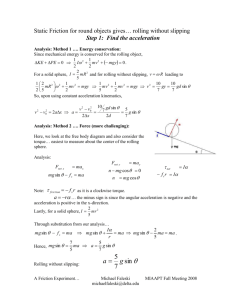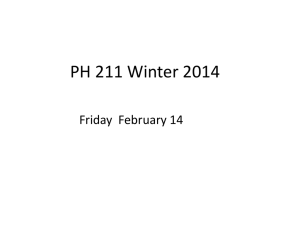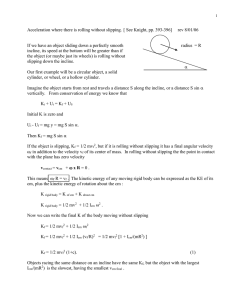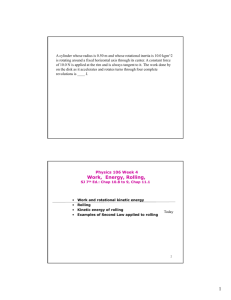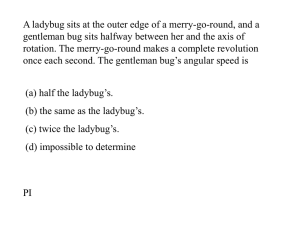Torque, Moment of Inertia & Rolling Motion Examples
advertisement
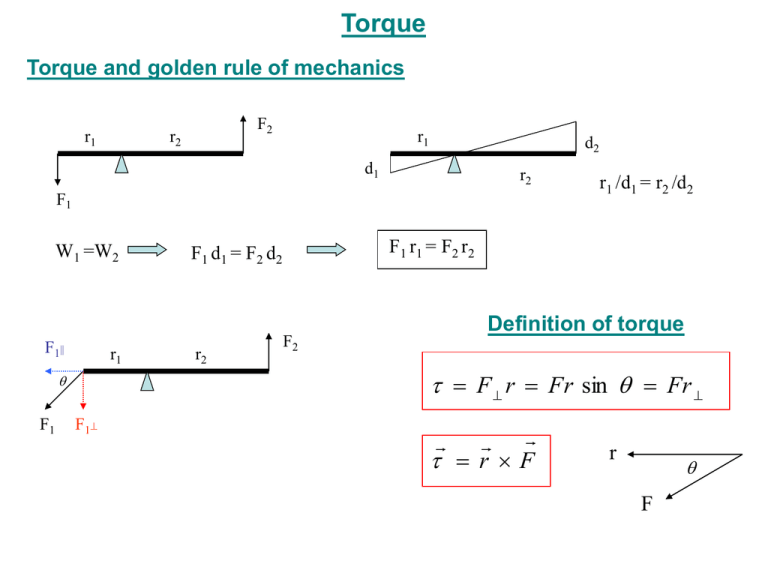
Torque Torque and golden rule of mechanics r1 F2 r2 r1 d2 d1 r2 F1 W1 =W2 F1|| r1 Definition of torque F2 F r Fr sin Fr F1 F1 r1 = F2 r2 F1 d1 = F2 d2 r2 r1 /d1 = r2 /d2 F1 rF r F Torque and moment of inertia F r F r ma tan r m r r mr 2 I Analog of Newton’s Law for rotation I mr 2 I Analog of mass for rotation m i ri 2 Example: Two blocks of masses m1 = 15 kg and m2 =20 kg are connected through a string that goes through the pulley of mass M = 2.00 kg and radiuss R = 25.0 cm. What is the angular acceleration of the pulley? R M I T2 T1 1 2 MR T 2 R T1 R a R Ma m 1 g m 2 m 1 1 2 M a T 2 T1 m 2 1 2 m 2 g T2 m 2 a m1g MR T1 m 1 g m 1 a m2g a 1 2 T 2 T1 R m2 m1 I 2 m 2 m 2 m1 m1 1 2 M g R 1 2 Ma 5 . 45 rad / s 2 2 a R Example: What is the angular acceleration of a tree as it falls down? Model of a tree as uniform rod of length L. mg 12 L cos I L 1 3 mL 2 mg 12 L cos 1 3 I a L 3 2 mL 2 3 g cos 2L g cos mg The top of the tree will have an acceleration larger than g when: 3 2 g cos g cos 2 3 48 . 2 v2 v cm v cm v cm v cm v cm Rolling v 3 2 v cm v 3 v cm + v4 v1 v cm v2 = 45° v cm 45° v4 v1 0 Rolling without slipping: v cm R Example: The rear wheel on a clown’s bicycle has twice the radius of the front wheel. Is the linear speed at the very top of the rear wheel greater than, less than, or the same as that of the front wheel? A. Twice greater than B. Twice less than C. Four times greater than D. Four times less than E. The same F. Non of these Example of Rolling: roller race Which of these get to the bottom of the ramp first? KE 1 2 KE 1 2 Mv 2 CM Mv 2 CM 1 2 I CM (1 k ) 2 1 2 k 2 CM Mv 1 2 v CM kMR R 2 2 I MR 2 Mgh 1 2 Mv CM (1 k ) 2 Example: Cylinder 1 is released on an incline and rolls down w/o slipping. Cylinder 2 has an initial angular speed at the bottom of the ramp and starts rolling up w/o slipping. What is the direction of the static friction force in each case? A. fs 1 Rolling down B. Vrelative Rolling up fs 2 C. Vrelative Friction must oppose relative motion. In the absence of friction: cylinder 1 would slide down (no rotation), cylinder 2 would keep rotating at the base of the ramp without going up. In both cases, relative velocity (at the point of contact) is down the incline, but for motion w/o slipping it should be zero, and fS must point up. The weight and the normal force produce zero torque about the CM. To produce “clockwise” angular acceleration and the appropriate torque direction (into the page), fS must point up in both cases. Example: A cylinder of mass M and radius R rolls down an incline of angle θ with the horizontal. If the cylinder rolls without slipping, what is its acceleration? Newton's 2nd law for rotation: f s R I CM Rolling without slipping: v CM R a CM R f s I CM 1 R 1 2 MR 2 I CM 1 2 MR fs 1 2 Ma CM a CM 1 R R 2 Mg sin f s Ma CM Newton's 2nd law for translation of the CM: N Mg sin fS a CM 2 3 3 2 Ma CM g sin compare to g sinθ, the results for an object sliding without friction mg θ Example: A disk of radius R and mass M that mounted on a massless shaft of radius r << R and rolling down an incline with a groove. What is its acceleration? M N fS R m~0 r I CM 1 2 MR 2 Mg M g sin fS M a C M a CM fS r I C M a CM r a CM M g sin M MR 2r 2 2 1 1 R 2r 2 2 M g sin I CM M 2 r g sin Very small if R >> r !
